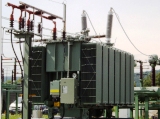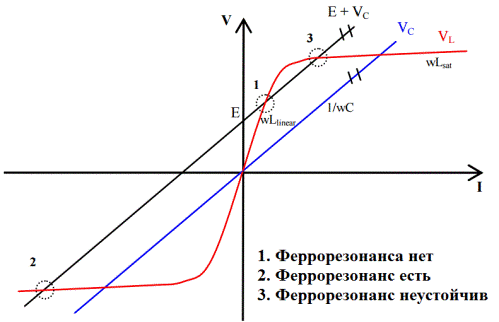Ferroresonance in electric circuits
 In 1907, the French engineer Joseph Bethenot published an article "On Resonance in Transformers" (Sur le Transformateur? Résonance), where he first drew attention to the phenomenon of ferroresonance.
In 1907, the French engineer Joseph Bethenot published an article "On Resonance in Transformers" (Sur le Transformateur? Résonance), where he first drew attention to the phenomenon of ferroresonance.
Directly, the term «ferroresonance», 13 years later, was also introduced by the French engineer and electrical engineering teacher Paul Bouchereau in his 1920 article entitled «The Existence of Two Regimes of Ferroresonance» (Öxistence de Deux Régimes en Ferroresonance). Bouchereau analyzed the phenomenon of ferroresonance and showed that there are two stable resonant frequencies in a circuit consisting of a capacitor, a resistor, and a nonlinear inductor.
Therefore, the phenomenon of ferroresonance is related to the nonlinearity of the inductive element in the circuit of the circuit... The nonlinear resonance that can occur in an electric circuit is called ferroresonance, and for its occurrence it is necessary that the circuit contains nonlinear inductance and ordinary capacitance.
Obviously, ferroresonance is absolutely not inherent in linear circuits. If the inductance in the circuit is linear and the capacitance is nonlinear, then a phenomenon similar to ferroresonance is possible.The main characteristic of ferroresonance is that a circuit is characterized by different modes of this nonlinear resonance, depending on the type of disturbance.
How can inductance be non-linear? Mainly due to the fact that magnetic circuit This element is made of a material that reacts nonlinearly to a magnetic field. Usually the cores are made of ferromagnets or ferrimagnets and when the term «ferroresonance» was introduced by Paul Bouchereau, the theory of ferrimagnetism was not yet fully formed and all materials of this kind were called ferromagnets, so the term «ferroresonance» arose to denote of the phenomenon of resonance in a circuit with a non-linear inductance.

Ferroresonance takes resonance with saturated inductance... In a conventional resonant circuit, the capacitive and inductive resistances are always equal to each other, and the only condition for overvoltage or overcurrent to occur is for the oscillations to match the resonant frequency, this is just one steady state and easy to prevent , by continuously monitoring the frequency or introducing active resistance.

The situation with ferroresonance is different. The inductive resistance is related to the magnetic flux density in the core, for example in the iron core of the transformer, and basically two inductive reactances are obtained, depending on the situation with respect to the saturation curve: linear inductive reactance and saturation induction reactance.

So ferroresonance, like resonance in an RLC circuit, can be of two main types: ferroresonance of currents and ferroresonance of voltages... When connecting inductance and capacitance in series, there is a tendency for ferroresonance of voltages, with a parallel connection, for ferroresonance of currents. If the circuit is highly branched, there are complex connections, then in this case it is impossible to say for sure whether there will be currents or voltages in it.
The ferroresonant mode can be fundamental, subharmonic, quasi-periodic or chaotic…. In the fundamental mode, the fluctuations in the currents and voltages correspond to the frequency of the system. In the subharmonic mode, the currents and voltages have a lower frequency, for which the fundamental frequency is harmonic. Quasi-periodic and chaotic modes are rare. The type of ferroresonant mode that occurs in the system depends on the system parameters and the initial conditions.
Ferroresonance under normal operating conditions of three-phase networks is unlikely, since the capacitances of the elements that make up the network are reduced by the inductance of the supply input network.
In networks with an ungrounded neutral, ferroresonance is more likely to occur in the incomplete phase mode. Isolation of the neutral leads to the fact that the capacitance of the network with respect to earth is in series with the power transformer and such conditions favor ferroresonance. Such an incomplete phase mode favorable for ferroresonance occurs when, for example, one of the phases is broken, there is an incomplete phase inclusion or an asymmetric short circuit.
The ferroresonance that suddenly appeared in the electrical network is harmful, it can cause equipment damage.The most dangerous is the fundamental mode of ferroresonance, when its frequency coincides with the fundamental frequency of the system. Subharmonic ferroresonance at frequencies 1/5 and 1/3 of the fundamental frequency is less dangerous because the currents are smaller. Thus, a large number of failures in power grids and other power systems are precisely related to ferroresonance, although at first the cause may seem obscure.
Interruptions, connections, transitional processes, lightning It can cause ferrorezonance. A change in network operation mode or an external influence or accident can initiate a ferroresonant mode, although this may not be noticeable for a long time.
Damage to voltage transformers is often caused precisely by ferroresonance, which leads to destructive overheating due to the action of currents exceeding all possible limits. To prevent such troubles related to overheating, technical measures are taken, related to a permanent or temporary increase of the active loss in the resonant circuit, minimizing the resonance effect. Such technical measures consist, for example, in that the magnetic circuit of the transformer is partially made of thick steel sheets.
